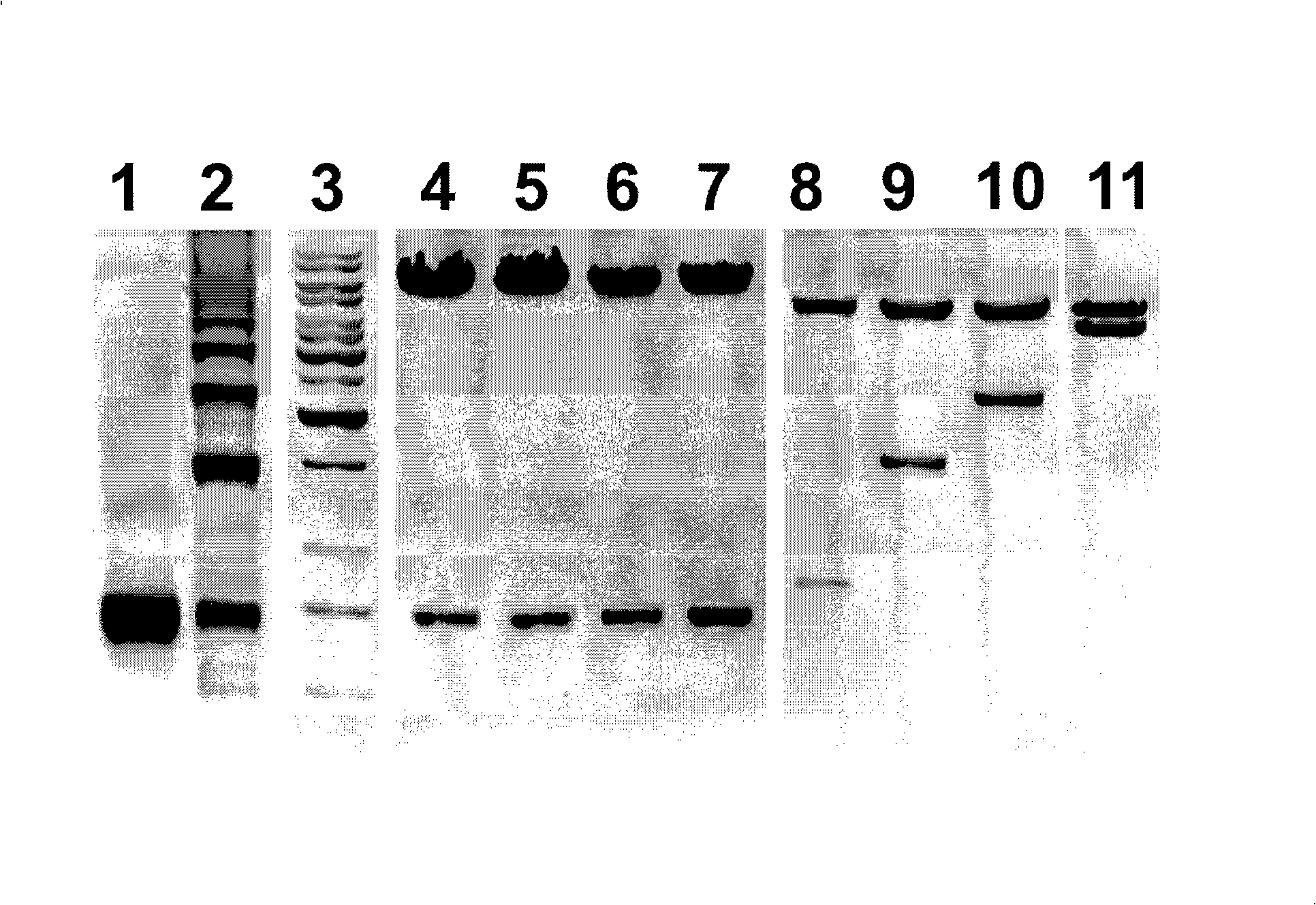Recombinant expression of multiprotein complexes using polygenes
A multi-gene and gene technology, applied in the field of expressing multi-protein complexes by using multi-gene recombination
- Summary
- Abstract
- Description
- Claims
- Application Information
AI Technical Summary
Problems solved by technology
Method used
Image
Examples
Embodiment 1
[0155] Embodiment 1: Prepare polygene and link in expression vector
[0156] The principle of multiple gene preparation is shown here by utilizing the human TATA-Box binding protein (hTBP) core (hTBPc, a c-terminal fragment of the full-length protein truncated at position 159). The gene encoding hTBPc was amplified by polymerase chain reaction (PCR) using a sense primer that binds to an overhang containing a RsrII restriction site and further encodes an amino acid spacer and tobacco etch The 5' end of the gene of the viral (TEV) cleavage site. The antisense primer binds to the 3' end of the gene and contains a RsrII restriction site. RsrII is a restriction enzyme that produces an asymmetric overhang of 3 nucleotides that cannot self-ligate, therefore, the restriction product is asymmetric and the ligation produces a directional product. The PCR product was digested with RsrII and purified. figure 1 The DNA (SEQ ID NO: 1 ) and deduced amino acid sequence (SEQ ID NO: 2) of...
Embodiment 2
[0158] Example 2: Construction of a baculovirus containing multiple genes encoding human universal transcription factor subunits carrier
[0159] Formation of polygenes inserted into the transfer vector pUCDMA expressed by baculovirus (see WO2005 / 085456A1 (PCT / EP2004 / 013381)) encoding polyproteins including human TBP-associated factors hTAF1 and hTAF2 in addition to hTBPc , the genes in the polygene are separated by sequences encoding amino acid spacers and TEV protease sites. Figure 9 A schematic diagram of the resulting construct pUCDMCSTAF1TBPcTAF2 is shown. The nucleotide sequence of this construct is shown in Figure 10 Medium (SEQ ID NO: 4). Another one that forms a polygene encoding a polyprotein including TEV protease and human TBP-associated factors hTAF6 and hTAF9 inserted into the transfer vector pFBDM expressed by baculovirus (see WO2005 / 085456A1 (PCT / EP2004 / 013381)) Constructs, the genes in the polygene are separated by sequences encoding amino acid spacer...
Embodiment 3
[0160] Example 3: Preparation of bacmid constructs, insect cell infection and protein expression
[0161] In order to construct bacmid constructs containing the above two polygenes, the constructs pUCDMCSTAF1TBPcTAF2 (pUCDM derivative) and pFDDO[HisTEVTAF6TAF9]his (pFBDM derivative) were each introduced in WO2005 / 085456A1 (PCT / EP2004 / 013381)) Example 5 (for pUCDMCSTAF1TBPcTAF2; Cre-lox site-specific recombination) and the DH10MultiBac described in Example 6 (for pFDDO[HisTEVTAF6TAF9]his; Tn7 transposition) Cre in cells. If desired, the DH10MultiBac described in WO2005 / 085456A1 (PCT / EP2004 / 013381) Cre One-step transposition / cre-lox site-specific recombination on cells. Preparation of bacmids, insect infection and protein expression can be carried out according to established methods (see, for example, O'Reilly et al. (1994) "Baculovirus expression vector. Alaboratory manual" Oxford University Press, New York-Oxford; "Bac -toBac TM Baculovirus Expression Systems Manual" I...
PUM
 Login to View More
Login to View More Abstract
Description
Claims
Application Information
 Login to View More
Login to View More - R&D
- Intellectual Property
- Life Sciences
- Materials
- Tech Scout
- Unparalleled Data Quality
- Higher Quality Content
- 60% Fewer Hallucinations
Browse by: Latest US Patents, China's latest patents, Technical Efficacy Thesaurus, Application Domain, Technology Topic, Popular Technical Reports.
© 2025 PatSnap. All rights reserved.Legal|Privacy policy|Modern Slavery Act Transparency Statement|Sitemap|About US| Contact US: help@patsnap.com



